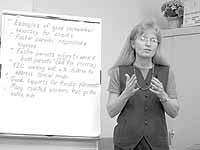| Reporting on the strengths of the Region Division of Family and Child Services is Laura Cameron from the Office of Services Review. Cameron was part of a presentation made April 19 regarding the state service. |
Local residents can think of the process as a report card for Utah’s eastern region division of child and family services.
As part of the Milestone plan, the division opened up 24 cases last week to a team of near 40 evaluators who spent hundreds of hours interviewing children, parents, grandparents, foster parents, case workers and judges.
The cases, all part of Utah’s seven eastern rural counties, including Carbon and Emery were each reviewed by a pair of evaluators.
Ten of the visiting team members were from Alabama, one was from from Washington, D.C., and the remaining panelists were Utahns. And the results – the division received a 95.2 percent score, compared to 83.3 percent last year and 77.8 percent in 2000.
The evaluators were looking at two major areas. One was the status of children in their family setting. The status could be anything from safety to permanence, stability to education, permanence, emotional well-being, and learning progress.
The second benchmark included a look at the system of care for the children areas that their needs are being met. The area included questions on child and family participating, the service team, planning, support systems and tracking and adaptation.
According to Beverly Hart, division of child and family services regional director, this is the third annual review and is an accumulation of all the efforts being made towards helping area children
“We find out through these reviews what works well and what needs improving,” said Hart last Friday addressing more than 50 regional case workers and community partners at the exit conference in Price.
“We are changing the way we do business with families and children,” added Hart.
Final comments were made by a trio or agency people, Aude Bermond Hamlett and Laura Cameron with the office of Service Review in Salt Lake City, and Linda Bayless, Child Welfare Policy and Practice Group, Alabama.
They explained that many of the interviews were conducted with focus groups and included family team meetings. In these cases there are families involved, a multitude of professionals who in a variety of ways work with the families and children.
There are over 215 children in this region involved in foster homes. In the final wrap-up none of the cases were specific and the evaluators talked only in generalities as to this region’s strengths and areas where there are improvement opportunities.
Strong points included successful team meetings and how extended families are included in determining what is best of the child. Caseworkers in these rural areas often have long distances to travel to work with the families and attend the meetings. It was noted that some community partners are still not willing to come to the table. Discussion was held on how to improve this.
There is a need for more foster homes and a lot of discussion was centered around children on Utah’s Native American Reservations.
They explained that this region has some very individualized plans and provide services for extended families. It is often a challenge to balance the system with the families and get the right people together.
They did report that Utah has one of the best computer systems in the country dealing with children’s needs. Utah is also on the cutting edge of the nation with more family driven programs, where the teams are looking for underlying causes and trying to design individual services to fit the families needs.
In the final report the team made four suggestions to improve the process in the Eastern Region. These included clarifying the processes of the functional assessment and family team meetings, more sharing between workers across the region, increasing the monitoring process and assisting in streamlining models and tools and developing more strategies relating to the Native American families.
The whole process is a partnership with lots of players and lots of people. Each child and each family is unique and many factors come into play as the family’s needs are reviewed and worked through. Just a few of these issues include mental and physical challenges, the balance between parents, extended families, foster parents, siblings, as well as the social problems that alcohol, drugs, and gambling play into a child’s life. These issues all then become part of a legal system, school system and state agencies as they determine which resources are available to assist the various situations.
The following principals have been taken from the Performance Milestone Plan and are a summary of the philosophies the agency practices. Children have the right to be safe from abuse and neglect, children and families need consistent nurturing in a healthy environment and all children need enduring relationships that provide a sense of family, stability, and belonging. Children and families have the right to be understood within the context of their own family rules, traditions, history and culture and Children can be assured a better chance for healthy personal growth and development in a safe home. The entire community shares the responsibility to create an environment that helps families raise children to their fullest potential, and committed, qualified, trained and skilled staff, supported by an effectively structured organization helps ensure positive outcomes for children and families. The final principal deals with children and families and their need for a relationship with an accepting, concerned, and empathic worker who can confront difficult issues and effectively assist individuals in their process towards positive change.

